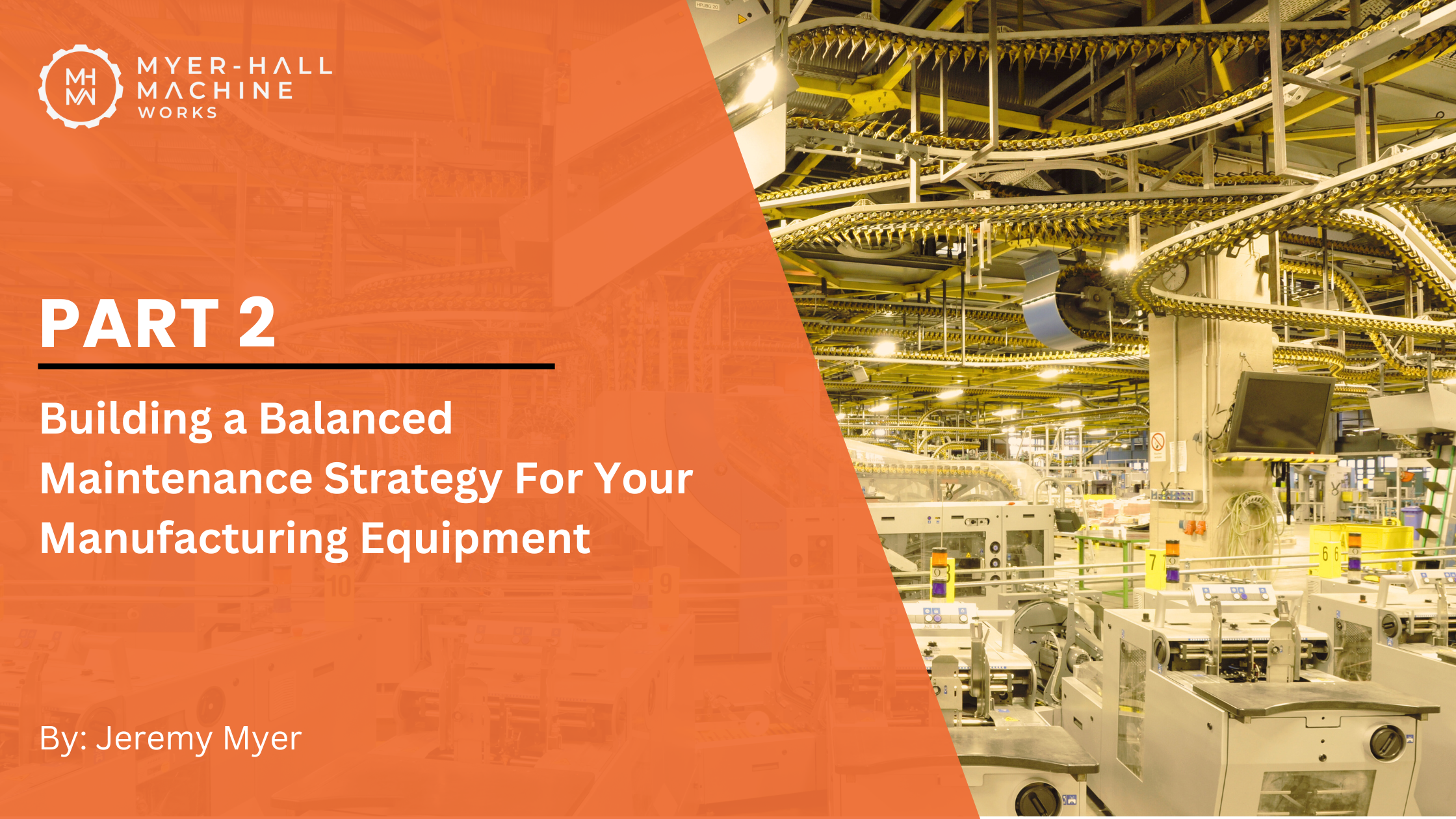Part 2: Building a Balanced Maintenance Strategy
December 16, 2024
Proactive maintenance is the key to staying competitive in manufacturing, where every second of uptime and every cent saved protects your tightening margins. As machines grow more sophisticated, manufacturers adopting a balanced maintenance strategy position themselves for stability, efficiency, and long-term success.
The Case for Preventive Maintenance
The line between preventive and reactive maintenance separates control from chaos. Reactive approaches that address issues only after they occur lead to unplanned downtime, escalating costs, and cascading equipment failures. Preventive strategies, however, mitigate these risks by focusing on planned inspections, repairs, and upgrades.
In Part 1, we explored the consequences of cutting corners on maintenance. To recap, proactive maintenance offers:
-
- Stability: A predictable schedule minimizes production disruptions.
- Cost Savings: Timely part replacements prevent costly failures.
- Safety: Reliable equipment reduces workplace accidents.
For many smaller manufacturers, shifting focus to preventive maintenance can feel like a heavy lift. However, the investment in time and resources pays off through efficiency, reliability, and long-term viability.
High-ROI Maintenance Practices
Adopting the right maintenance practices maximizes returns while maintaining a lean operation. Among the most impactful are usage-based and predictive maintenance.
1. Usage-Based Maintenance
Schedule servicing based on actual equipment use rather than a fixed calendar. Variables like operating hours, load cycles, and environmental conditions determine maintenance needs. For example, a conveyor belt running 24/7 will require more frequent attention than one used intermittently.
Recommendations:
-
-
-
-
-
- Audit Equipment Usage: Categorize machines by operating intensity and prioritize heavily used assets for maintenance.
- Set Custom Thresholds: Analyze historical data to define wear patterns and adjust service intervals.
- Empower Operators: Train staff to identify early signs of wear, such as misaligned belts or unusual vibrations.
- Use Tracking Tools: Implement runtime counters or sensors to log operational data, enabling maintenance scheduling based on actual usage.
-
-
-
-
2. Predictive Maintenance
Takes usage-based maintenance further by employing analytics and monitoring tools to identify potential issues before they cause downtime.
Our Real-World Example:
A manufacturer equipped with robotic arms with sensors tracked energy consumption. When a joint began drawing excessive power, the system flagged the anomaly. Alerted to the problem, technicians found an oil fill cap had been worn off during operation where the cap had rubbed against a mating machine, causing a nearly unnoticeable amount of oil to be leaked out during operation. A minor adjustment resolved the issue, avoiding a major breakdown.
Recommendations:
-
-
-
-
- Start Small: Pilot predictive tools on critical machines to measure ROI.
- Invest in Scalable Solutions: Select monitoring systems that integrate with existing machinery and software.
- Prioritize Data Collection: Use sensors to track metrics like vibration and temperature, building a baseline for spotting anomalies.
- Collaborate with Experts: Partner with solution providers to set up systems, interpret data, and train your team.
- Take Action on Alerts: Ensure accountability for responding promptly to flagged issues.
-
-
-
Tools and Technologies Shaping Modern Maintenance
Modern tools make proactive maintenance accessible and precise. Sensors, automation, and data insights enable manufacturers to detect and address issues faster.
1. Sensors and Monitoring Systems:
Embedded sensors measure metrics like temperature, vibration, and energy use, providing real-time diagnostics and enabling precision maintenance.
Recommendations:
-
-
-
-
- Focus on Key Metrics: Use sensors to track critical performance indicators for high-value assets.
- Retrofit Older Machines: Upgrade legacy equipment with sensor technology where feasible.
- Centralize Data: Integrate sensor readings into a platform that consolidates trends and alerts.
- Set Actionable Thresholds: Define acceptable ranges for each metric and ensure your team knows how to respond to anomalies.
-
-
-
2. The Role of Automation:
Automation complements preventive strategies by reducing repetitive tasks and human error. Robots can autonomously perform inspections, collect data from hard-to-reach areas, and communicate with monitoring systems to identify deviations.
Recommendations:
-
-
-
-
- Prioritize High-Impact Areas: Deploy automation for error-prone or hazardous tasks.
- Evaluate ROI: Start small, targeting processes where automation reduces labor costs and downtime.
- Invest in Flexible Robotics: Choose scalable solutions adaptable to tasks like inspections, material handling, or cleaning.
- Upskill Your Workforce: Train staff to operate and maintain automated systems, ensuring smooth integration.
-
-
-
Mindset Shifts for Long-Term Success
A balanced maintenance strategy isn’t just technical—it’s cultural. Many businesses adopt proactive practices only after costly failures force change. Embracing this shift earlier can prevent crises altogether.
1. Lessons from Neglect:
Over time, small inefficiencies—like frequent machine stoppages—become normalized. Addressing root causes rather than symptoms prevents larger problems from taking hold.
2. Building a Culture of Reliability:
Proactive maintenance requires buy-in from leadership and staff. Simple changes, like engaging operators in spotting early warning signs, foster shared responsibility and pride in well-maintained equipment.
Getting Started: Three Immediate Steps You Can Take to Help You Build A Balanced Maintenance Strategy
For manufacturers ready to adopt a balanced maintenance strategy, here are three steps to begin:
-
-
- Evaluate Critical Equipment: Identify high-priority machines with no backups or frequent failures.
- Shift to Preventive Protocols: Transition from reactive fixes to scheduled inspections and OEM-recommended intervals.
- Leverage Quick Wins: Implement short, frequent checks for wear and tear, such as:
-
-
- Testing hydraulic fluid instead of replacing it unnecessarily.
- Monitoring sound and vibration changes to identify loose components.
-
-
-
The Takeaway: Investing in Your Equipment is Investing in Your Future
As machinery becomes more complex and competition intensifies, those prioritizing maintenance will lead the pack. Much like regular health checkups, proactive care ensures the longevity and vitality of your operations. The choice is clear: invest today or pay the price of neglect tomorrow.
For more insights into enhancing production through tailored solutions, subscribe to our blog (and follow on LinkedIn) to stay updated on strategies and industry trends.
 Written by Jeremy Myer, Co-Founder of Myer-Hall Machine Works.
Written by Jeremy Myer, Co-Founder of Myer-Hall Machine Works.

